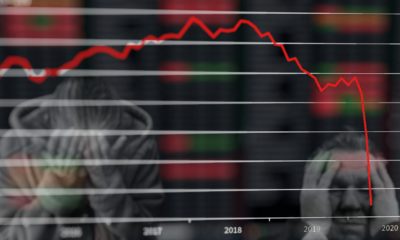Business
Bond Market Chaos to Increase by March 2024
Most of the carnage in the bond market currently is due to the overwhelming supply issuance, which is a direct consequence of our intractable debt and deficits and the absence of foreign buyers. In fact, they have become sellers of our debt. Just imagine the chaos that will occur in the next few months when this major source of readily accessible Treasury liquidity runs dry.

The major issue with the bond market right now is the overwhelming amount of bond issuance combined with the notable absence of the usual buyers. In other words, the illiquidity is already causing U.S. sovereign debt to trade like a microcap penny stock. This dysfunctional trading environment should become exponentially worse by the end of Q1 2024.
The U.S. national debt is now $33.5T, and the interest on that debt is $712b so far this year. That interest expense is set to double over the next few years as our debt is rolling over at much higher interest rates. Interest payments equal to 17% of all Federal revenue and should easily jump to 35% of all income very soon. The deficits will be much greater when the recession arrives, as the automatic economic stabilizers kick in, just as revenue also collapses.
Entitlements and debt service payments will equal 100% of all revenue by 2040 at the very latest. At that point, there will be no room for any other government spending. Our bond market is fracturing, and it is becoming an existential crisis for our financial system. What else would you expect when the nation’s annual deficit is 45% of our revenue, and that is adding on each year to the national debt, which is an incredible 771% of annual federal income!
I have explained the reasons why long-duration bonds have been a no-touch for the past several months. China is having to sell Treasuries to support the Yuan. Japan is doing the same to boost the Yen, in addition to relaxing yield curve control, which increases the relative attractiveness of JGBs over U.S. bonds. Disinflation is being replaced by reflation, and the Atlanta Fed’s incredible 5% prediction for Q3 GDP is putting more upward pressure on yields and keeping potential buyers at bay.
The big surprise here is that this volatility is occurring while there is still $1.2 trillion in the Fed’s Reverse Repo (RRP) facility. Banks first parked their excess reserves, which were the result of the massive COVID stimulus packages from the Treasury, at the Fed to earn risk-free interest. That figure reached a high of $2.5 trillion in December of 2022.
However, in the last 5 months, the amount in the RRP has crashed by over $1 trillion. This is, in essence, funding the Fed’s Q.T. program. If the current pace of RRP selling continues, the number of excess reserves parked at the Fed will be near zero by March 2024. It will be at that point that much of the liquidity in the bond market will have evaporated.
As mentioned, most of the carnage in the bond market currently is due to the overwhelming supply issuance, which is a direct consequence of our intractable debt and deficits and the absence of foreign buyers. In fact, they have become sellers of our debt. Just imagine the chaos that will occur in the next few months when this major source of readily accessible Treasury liquidity runs dry.

There are only two ways to possibly save us from the coming bond market collapse
The first is an immediate and complete restructuring of S.S., Medicare, Medicaid, and Defense that includes humongous cuts in benefits across the board. This will be as easy for Congress to accomplish as a camel going through the eye of a needle. And if the impossible does occur, the concomitant resulting recession would be so catastrophic that it might end up rendering the nation insolvent anyway.
The other temporary salve would be if the delayed recession were to occur imminently. That would send investors scurrying out of equities and into the relative safety of U.S. bonds. However, again, the resulting amount of red ink from the election of the automatic economic stabilizers would send deficits and debt skyrocketing from their already untenable $2 trillion level. During the last two recessions, annual deficits increased by over 200%. Hence, the U.S.’s insolvency fate would be sealed regardless, as the annual amount of red ink could jump to $6 trillion, or an incredible nearly 25% of our entire GDP.
In the same month the RRP facility runs out, the $100 billion in distressed bank assets currently festering in the Bank Term Funding Program are scheduled to return to these financial institutions at a fraction of par value. Banks must then give the Fed 100 cents on the dollar plus accrued interest.
Remember that these impaired assets threatened to render the entire regional banking sector insolvent at the start of this year. These Treasuries, MBS, and corporate bonds are even further underwater than when Mr. Powell first allowed them to be parked at the Fed. Oh, and by the way, March of next year will also be when the full lagged effects of 500bps in monetary tightening will begin to have their maximum impact.
Hence, within the next 5 months, the bond market should spiral into complete chaos, and the Fed will be forced to end Q.T., start cutting interest rates towards the zero bound, and venture back into Q.E. once again. The stagflationary ramifications of all this will be staggering, especially since no investor will be duped into believing the Fed can adroitly fight inflation without crippling the banking system and the economy and risking a sovereign U.S. debt crisis.
The stock market will not remain unscathed at all
According to Bank of America, about one-third of all companies in the Russell 2000 are not profitable. These company’s very existence depends on their ability to borrow money at ultra-low interest rates. Two years ago, they could borrow new funds to keep the lights on below 4%; today it will cost them 9.3%.
This is an existential crisis for 33% of small businesses, which are the engine of employment growth. Therefore, the labor market should begin to fracture by early 2024. A spiking unemployment rate will cause the real estate market to suffer the same dire fate as the bond and stock markets.
There is still some money to be made in the overall market until the end of Q1 2024 arrives. However, this is especially crucial for the 60/40 portfolio bag holders; you better be able to identify when the freezing of the debt markets is about to arrive because securities could get wiped out across the board.
The swings between inflation and deflation will become more violent and destructive over time. Active and smart management is the best hope to survive and thrive in this chaos.
As always, we Pray for peace and try to love people as ourselves—this is how we prove our love for God is real.
__
(Featured image by Alice Pasqual via Unsplash)
DISCLAIMER: This article was written by a third party contributor and does not reflect the opinion of Born2Invest, its management, staff or its associates. Please review our disclaimer for more information.
This article may include forward-looking statements. These forward-looking statements generally are identified by the words “believe,” “project,” “estimate,” “become,” “plan,” “will,” and similar expressions. These forward-looking statements involve known and unknown risks as well as uncertainties, including those discussed in the following cautionary statements and elsewhere in this article and on this site. Although the Company may believe that its expectations are based on reasonable assumptions, the actual results that the Company may achieve may differ materially from any forward-looking statements, which reflect the opinions of the management of the Company only as of the date hereof. Additionally, please make sure to read these important disclosures.

-

 Crypto2 weeks ago
Crypto2 weeks agoTether Defends USDT After S&P Downgrade Amid Growing Calls for Transparency
-

 Fintech2 days ago
Fintech2 days agoArgentina’s Banks Poised to Integrate Cryptocurrencies, Paving Way for Widespread Adoption
-

 Biotech1 week ago
Biotech1 week agoAngelini Ventures Signs €150 Million EIB Deal to Accelerate Biotech Innovation in Europe
-

 Crypto5 days ago
Crypto5 days agoEuropean Selling Drives Bitcoin’s November Slump
























